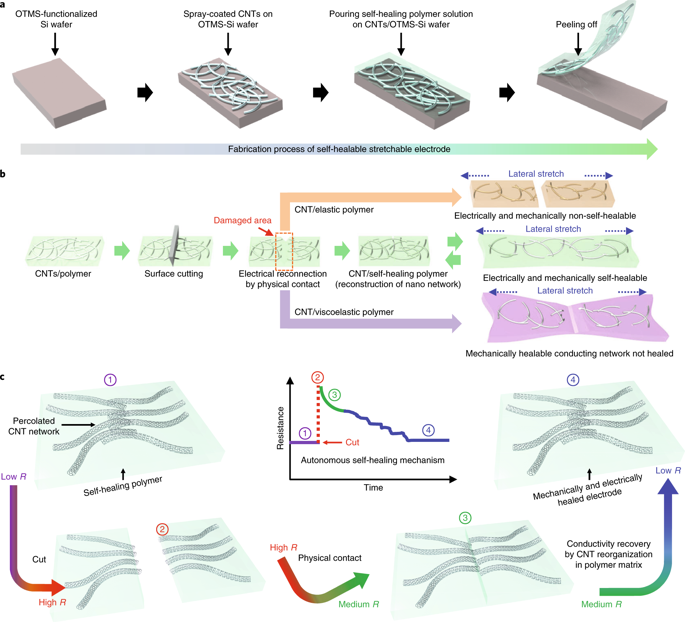Nature Nanotechnology ( IF 38.1 ) Pub Date : 2018-08-20 , DOI: 10.1038/s41565-018-0244-6 Donghee Son , Jiheong Kang , Orestis Vardoulis , Yeongin Kim , Naoji Matsuhisa , Jin Young Oh , John WF To , Jaewan Mun , Toru Katsumata , Yuxin Liu , Allister F. McGuire , Marta Krason , Francisco Molina-Lopez , Jooyeun Ham , Ulrike Kraft , Yeongjun Lee , Youngjun Yun , Jeffrey B.-H. Tok , Zhenan Bao

|
Electronic skin devices capable of monitoring physiological signals and displaying feedback information through closed-loop communication between the user and electronics are being considered for next-generation wearables and the ‘Internet of Things’. Such devices need to be ultrathin to achieve seamless and conformal contact with the human body, to accommodate strains from repeated movement and to be comfortable to wear. Recently, self-healing chemistry has driven important advances in deformable and reconfigurable electronics, particularly with self-healable electrodes as the key enabler. Unlike polymer substrates with self-healable dynamic nature, the disrupted conducting network is unable to recover its stretchability after damage. Here, we report the observation of self-reconstruction of conducting nanostructures when in contact with a dynamically crosslinked polymer network. This, combined with the self-bonding property of self-healing polymer, allowed subsequent heterogeneous multi-component device integration of interconnects, sensors and light-emitting devices into a single multi-functional system. This first autonomous self-healable and stretchable multi-component electronic skin paves the way for future robust electronics.
中文翻译:

通过动态重建纳米结构导电网络制造的集成式可自愈电子皮肤系统
下一代可穿戴设备和“物联网”正在考虑能够监视生理信号并通过用户与电子设备之间的闭环通信显示反馈信息的电子皮肤设备。这样的设备需要超薄以实现与人体的无缝和共形接触,以适应反复运动产生的应力并使佩戴舒适。近来,自愈化学已经推动了可变形和可重构电子器件的重要进步,尤其是在以自愈电极为主要推动力的情况下。与具有可自我修复的动态特性的聚合物基材不同,被破坏的导电网络在损坏后无法恢复其可拉伸性。这里,我们报告了与动态交联的聚合物网络接触时导电纳米结构自重构的观察结果。结合自修复聚合物的自粘合性能,可以将互连,传感器和发光设备的后续异构多组件设备集成到单个多功能系统中。这是第一个自主的可自我修复且可拉伸的多组分电子皮肤,为将来的强大电子产品铺平了道路。











































 京公网安备 11010802027423号
京公网安备 11010802027423号